 4
4 B
Step-by-step explanation:
 4
4 B
Step-by-step explanation:
 66
66 there's one more screen shot but the limit is 5... so ill type it out!
7. Are the two products the same when you multiply them vertically? (1 point)
Yes they are
Making a Decision:
8. Who was right, Emily or Zach? Are the products the same with the three different methods of multiplication? (1 point)
They were both correct
9. Which of these three methods is your preferred method for multiplying polynomials? Why? (1 point)
I prefer the first one, Table method. To me it is easier and the fastest out of them all.
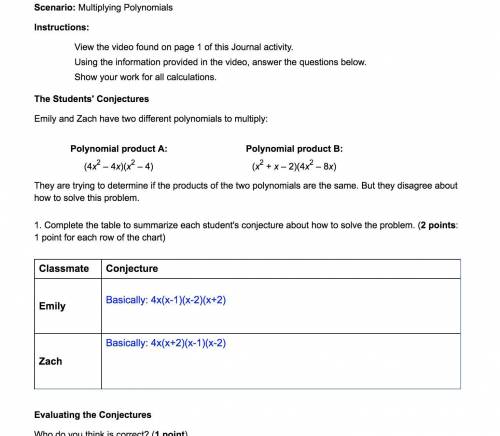
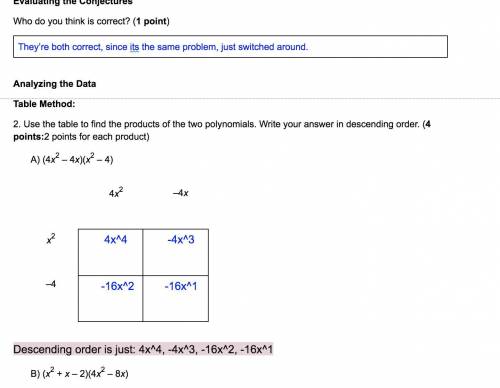
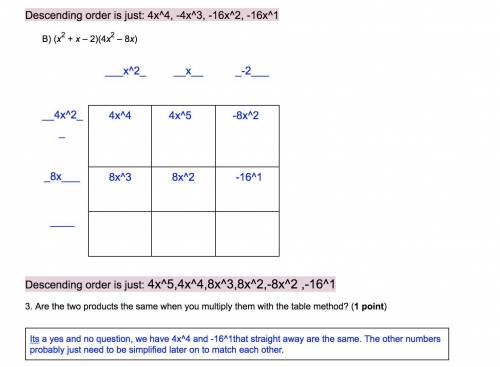
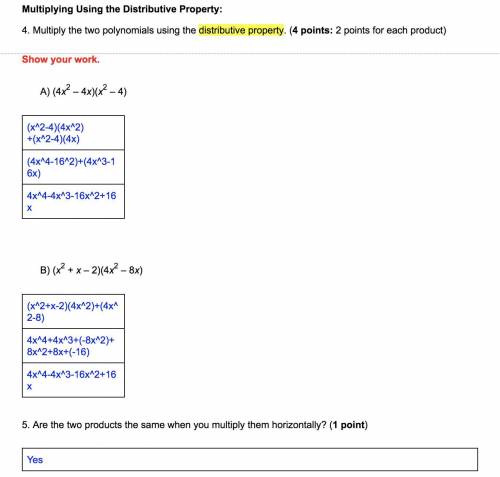
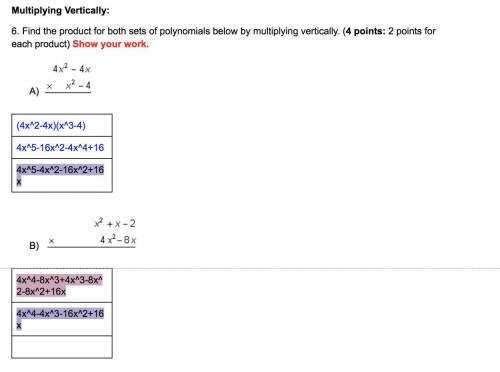
 66
66 there's one more screen shot but the limit is 5... so ill type it out!
7. Are the two products the same when you multiply them vertically? (1 point)
Yes they are
Making a Decision:
8. Who was right, Emily or Zach? Are the products the same with the three different methods of multiplication? (1 point)
They were both correct
9. Which of these three methods is your preferred method for multiplying polynomials? Why? (1 point)
I prefer the first one, Table method. To me it is easier and the fastest out of them all.





 2
2 Step-by-step explanation:
We have the polynomial
 ( 1 )
( 1 )
To solve this problem we have to take into account that only we can sum term with the same order in the variable. We have the polynomials

we can note (by summing term by term) that only the sum of the first and the fourth equation correspond to the given polynomial ( 1 ) of the problem. If we organize these polynomials (that is, write the equation down in a form where higher order appears first ) we have

and if we sum we obtain

that is what we was looking for
I hope this is useful for you
regards
 2
2  2
2 Step-by-step explanation:
We have the polynomial
 ( 1 )
( 1 )
To solve this problem we have to take into account that only we can sum term with the same order in the variable. We have the polynomials

we can note (by summing term by term) that only the sum of the first and the fourth equation correspond to the given polynomial ( 1 ) of the problem. If we organize these polynomials (that is, write the equation down in a form where higher order appears first ) we have

and if we sum we obtain

that is what we was looking for
I hope this is useful for you
regards
 2
2  22
22 Part 1 is explained in 1) of the explanation.
Part 2 is explained in 2) of the explanation.
Step-by-step explanation:
1) So you choose 45 and to write it as 50-5.
We want to square 45 without using a calculator.
That is we want to find  without a calculator.
without a calculator.

 by your identity
by your identity  .
.




-----------
2) Choose two numbers for  and
and  between 8 and 15. I will choose 10
between 8 and 15. I will choose 10  and 12
and 12  .
.





Now we have to multiply 22 and 124 without a calculator...
22(124)
(20+2)(124)
124(20)+124(2)
124(10+10)+124(2)
1240+1240+248
2480+248
2728
 22
22 Part 1 is explained in 1) of the explanation.
Part 2 is explained in 2) of the explanation.
Step-by-step explanation:
1) So you choose 45 and to write it as 50-5.
We want to square 45 without using a calculator.
That is we want to find  without a calculator.
without a calculator.

 by your identity
by your identity  .
.




-----------
2) Choose two numbers for  and
and  between 8 and 15. I will choose 10
between 8 and 15. I will choose 10  and 12
and 12  .
.





Now we have to multiply 22 and 124 without a calculator...
22(124)
(20+2)(124)
124(20)+124(2)
124(10+10)+124(2)
1240+1240+248
2480+248
2728

It will provide an instant answer!
